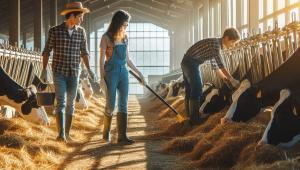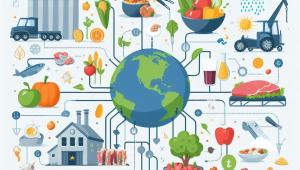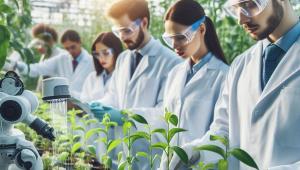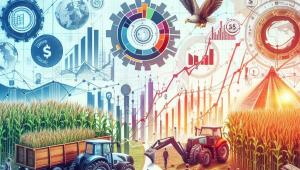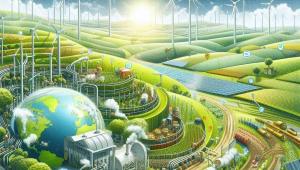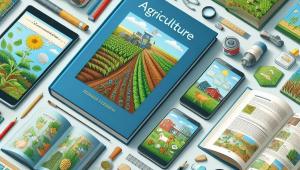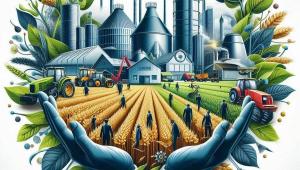Sustainable agriculture is an approach to food production that aims to meet the needs of the present generation without compromising the ability of future generations to meet their own needs. It seeks to optimize the use of natural resources, minimize environmental impacts, and ensure the long-term viability of agricultural systems. In the face of growing global challenges such as climate change, population growth, and resource scarcity, sustainable agriculture has emerged as a critical solution for feeding the world while protecting the planet.
The Need for Sustainable Agriculture
Growing Global Population and Food Demand
The world's population is expected to reach 9.7 billion by 2050, up from 7.7 billion in 2019. This growth, combined with changing diets and increasing demand for animal products, is expected to drive a 60% increase in global food demand by mid-century. Meeting this demand will require significant increases in agricultural productivity, but also a shift towards more sustainable and efficient production methods.
Environmental Impacts of Conventional Agriculture
Conventional agriculture, characterized by monocultures, heavy use of synthetic inputs, and intensive tillage, has had significant negative impacts on the environment. These impacts include:
Land degradation and soil erosion
Intensive tillage and monocropping have led to the loss of soil organic matter, reduced soil fertility, and increased erosion. Globally, an estimated 24 billion tons of fertile soil are lost annually due to erosion.
Water pollution and depletion
Agriculture is the largest consumer of freshwater resources, accounting for 70% of global water withdrawals. Nutrient runoff from fertilizers and manure can pollute waterways, leading to eutrophication and dead zones in coastal areas.
Biodiversity loss
The expansion of agricultural lands has led to the destruction of natural habitats and the loss of biodiversity. Agriculture is a major driver of deforestation, with an estimated 80% of global deforestation due to agricultural expansion.
Greenhouse gas emissions
Agriculture is a significant contributor to climate change, accounting for 24% of global greenhouse gas emissions. The majority of these emissions come from livestock production, rice cultivation, and the use of synthetic fertilizers.
Socio-Economic Challenges in Agriculture
In addition to environmental challenges, agriculture faces significant socio-economic challenges, including:
Farming in a challenging economic environment
Many farmers struggle to remain profitable in the face of rising input costs, low commodity prices, and increasing market consolidation.
Aging farmer population and lack of succession
The average age of farmers is increasing globally, and many farmers lack clear succession plans for their operations.
Corporate concentration in agricultural inputs and food processing
A small number of large corporations control a significant share of the market for seeds, fertilizers, and other inputs, as well as food processing and distribution. This concentration can limit choices for farmers and consumers and make it difficult for small and mid-sized operations to compete.
Key Principles of Sustainable Agriculture
Environmental Stewardship
Sustainable agriculture seeks to protect and enhance natural resources through practices that:
Protect and enhance soil health
Sustainable agriculture practices such as reduced tillage, cover cropping, and crop rotation can improve soil structure, increase organic matter, and reduce erosion.
Conserve water and improve water quality
Practices such as drip irrigation, rainwater harvesting, and precision irrigation scheduling can reduce water use and improve water efficiency. Buffer strips, wetlands, and other conservation practices can help to reduce nutrient runoff and improve water quality.
Promote biodiversity
Sustainable agriculture seeks to maintain and enhance biodiversity through practices such as agroforestry, intercropping, and the use of native plant species. These practices can provide habitat for wildlife, improve ecosystem services, and increase the resilience of agricultural systems.
Economic Viability
Sustainable agriculture must be economically viable for farmers to be widely adopted. Key strategies for ensuring economic viability include:
Diversifying income streams
Many sustainable farmers rely on a diverse range of income sources, including value-added products, agritourism, and ecosystem services payments.
Reducing input costs
Sustainable agriculture practices such as reduced tillage, cover cropping, and integrated pest management can help to reduce the need for expensive inputs such as fertilizers and pesticides.
Accessing premium markets
Some consumers are willing to pay a premium for sustainably-produced foods, creating opportunities for farmers to capture additional value through certification and labeling programs.
Social Responsibility
Sustainable agriculture has a responsibility to ensure the well-being of farmers, workers, and communities. This includes:
Ensuring safe and fair working conditions
Sustainable agriculture operations should provide safe working conditions, fair wages, and benefits for all workers.
Supporting local communities
Sustainable agriculture can support local economies by creating jobs, generating tax revenue, and providing other social and economic benefits.
Ensuring access to healthy and affordable food
Sustainable agriculture has a role to play in ensuring that all people have access to healthy, affordable, and culturally appropriate food.
Sustainable Agricultural Practices
There is a wide range of sustainable agriculture practices that can help to achieve the key principles outlined above. Some of the most common and effective practices include:
Soil Health Management
Reduced tillage and no-till farming
These practices minimize soil disturbance, reducing erosion and improving soil structure and water retention.
Cover cropping and crop rotation
Planting cover crops and rotating crops can help to reduce erosion, improve soil fertility, and break pest and disease cycles.
Composting and organic amendments
Adding compost, manure, and other organic amendments can improve soil health and fertility.
Water Conservation and Management
Drip irrigation and micro-sprinklers
These systems deliver water directly to plant roots, reducing evaporation and improving water efficiency.
Rainwater harvesting and storage
Collecting and storing rainwater can provide a source of irrigation water during dry periods.
Precision irrigation scheduling
Using soil moisture sensors and weather data to schedule irrigation can help to reduce water use and improve crop yields.
Integrated Pest Management (IPM)
Biological control methods
Using natural predators and parasites to control pest populations can reduce the need for chemical pesticides.
Cultural control practices
Practices such as crop rotation, intercropping, and sanitation can help to reduce pest pressure and minimize the need for chemical controls.
Targeted and judicious use of pesticides
When pesticides are necessary, using them in a targeted and judicious manner can minimize negative impacts on human health and the environment.
Agroforestry and Silvopasture
Integrating trees into crop and livestock systems
Planting trees in agricultural landscapes can provide a range of benefits, including improved soil health, increased biodiversity, and additional income streams.
Carbon sequestration potential
Trees and other perennial vegetation can sequester significant amounts of carbon in their biomass and soils, helping to mitigate climate change.
Organic Farming
Principles and practices of organic agriculture
Organic farming relies on natural processes and inputs to manage soil fertility, pests, and diseases, and prohibits the use of synthetic fertilizers and pesticides.
Certification standards and labeling
Organic certification programs provide standards and labeling for organic products, helping consumers identify and support sustainable agriculture practices.
Market demand and consumer preferences
Demand for organic products has grown significantly in recent years, driven by consumer preferences for healthy, sustainable, and ethically produced foods.
Regenerative Agriculture
Focus on rebuilding soil organic matter and restoring degraded soil biodiversity
Regenerative agriculture seeks to rebuild soil health through practices such as no-till farming, cover cropping, and composting.
Integration of livestock and cropping systems
Integrating livestock into cropping systems can provide a range of benefits, including improved soil fertility, increased biodiversity, and additional income streams.
Emphasis on closed-loop nutrient cycling
Regenerative agriculture seeks to minimize external inputs and maximize the recycling of nutrients within the farm system.
Sustainable Livestock Production
Grazing Management
Rotational and managed intensive grazing
These practices involve moving livestock through a series of paddocks, allowing for rest and recovery of forage plants and improved soil health.
Benefits for soil health, forage quality, and animal welfare
Well-managed grazing can improve soil structure, increase forage productivity and quality, and provide a more natural and healthy environment for livestock.
Pasture-Based Systems
Grass-fed and grass-finished livestock
These systems rely on pasture as the primary source of feed for livestock, rather than grain-based feeds.
Environmental and nutritional benefits
Pasture-based systems can reduce greenhouse gas emissions, improve soil health, and produce meat and dairy products with improved nutritional profiles.
Animal Welfare Considerations
Providing natural living conditions: Sustainable livestock production seeks to provide animals with natural living conditions, including access to pasture, fresh air, and sunlight.
Minimizing stress and promoting health
Practices such as low-stress handling, appropriate stocking densities, and preventive health care can help to minimize stress and promote animal health and well-being.
Manure Management and Nutrient Cycling
Composting and anaerobic digestion
These practices can help to stabilize manure and reduce greenhouse gas emissions, while producing valuable soil amendments and renewable energy.
Nutrient management planning
Careful planning and management of manure and other nutrient sources can help minimize nutrient losses and reduce the risk of water pollution.
Local and Regional Food Systems
Sustainable agriculture is closely linked to the development of local and regional food systems that connect farmers and consumers more directly. Some key components of these systems include:
Community Supported Agriculture (CSA)
Direct partnership between farmers and consumers
In a CSA, consumers purchase a share of a farm's harvest in advance, providing the farmer with a guaranteed market and a source of working capital.
Shared risks and rewards of food production
CSAs allow consumers to share in both the risks and rewards of farming, creating a stronger connection between farmers and eaters.
Farmers Markets and Direct-to-Consumer Sales
Providing fresh, local produce to communities
Farmers markets and other direct-to-consumer sales outlets provide a way for farmers to sell fresh, locally-grown produce directly to consumers.
Supporting small and mid-sized farms
These markets can provide an important source of income for small and mid-sized farms that may struggle to compete in larger wholesale markets.
Farm-to-School and Farm-to-Institution Programs
Connecting local farms with schools and hospitals
Farm-to-school and farm-to-institution programs seek to connect local farms with schools, hospitals, and other institutions, providing a reliable market for farmers and a source of fresh, healthy food for consumers.
Improving access to healthy, locally-grown food
These programs can help to improve access to healthy, locally-grown food, particularly in underserved communities.
Urban Agriculture and Community Gardens
Producing food in cities and towns
Urban agriculture and community gardens can provide a way for people to grow their food in urban and suburban areas.
Building community and increasing food security
These initiatives can help to build community, increase food security, and provide access to fresh, healthy produce in areas that may lack access to traditional grocery stores.
Sustainable Agriculture and Climate Change
Agriculture's Contribution to Greenhouse Gas Emissions
Agriculture is a significant contributor to climate change, accounting for an estimated 24% of global greenhouse gas emissions. The main sources of these emissions include:
Methane from livestock and rice cultivation
Livestock, particularly cattle, are a significant source of methane emissions, while flooded rice paddies also produce methane.
Nitrous oxide from fertilizer use
The application of nitrogen fertilizers can lead to the release of nitrous oxide, a potent greenhouse gas.
Carbon dioxide from deforestation and land use change
The clearing of forests and other natural habitats for agricultural expansion releases large amounts of carbon dioxide into the atmosphere.
Climate Change Impacts on Agriculture
At the same time, agriculture is also highly vulnerable to the impacts of climate change, including:
Changing temperature and precipitation patterns
Rising temperatures and changes in precipitation patterns can affect crop yields and the availability of water for irrigation.
Increased frequency and intensity of extreme weather events
More frequent and intense droughts, floods, and storms can damage crops and livestock and disrupt food supply chains.
Shifts in crop suitability and pest pressure
Changes in temperature and precipitation can alter the geographic range of crops and the distribution of pests and diseases.
Sustainable Agriculture as a Climate Change Mitigation Strategy
Sustainable agriculture practices can help to mitigate climate change by reducing greenhouse gas emissions and sequestering carbon in soils and biomass. Some key strategies include:
Reducing greenhouse gas emissions through sustainable practices
Practices such as reduced tillage, precision fertilizer application, and improved manure management can help to reduce greenhouse gas emissions from agriculture.
Sequestering carbon in soils and biomass
Practices such as cover cropping, agroforestry, and the use of perennial crops can help to sequester carbon in soils and biomass, offsetting greenhouse gas emissions from other sources.
Adapting to changing climate conditions
Sustainable agriculture practices can also help farmers to adapt to changing climate conditions, for example by improving soil moisture retention, reducing water use, and diversifying crop and livestock systems.
Policy and Institutional Support for Sustainable Agriculture
Achieving a transition to sustainable agriculture at a large scale will require supportive policies and institutions at the local, national, and international levels. Some key areas of policy and institutional support include:
Government Programs and Incentives
Conservation programs and cost-share assistance
Government programs can provide financial assistance and technical support for farmers to adopt sustainable practices such as cover cropping, reduced tillage, and nutrient management.
Research and extension services
Public research and extension programs can help to develop and disseminate sustainable agriculture practices and technologies.
Crop insurance and risk management tools
Government-supported crop insurance and other risk management tools can help farmers manage the risks associated with transitioning to sustainable practices.
Private Sector Initiatives
Sustainable sourcing commitments from food companies
Food companies can drive demand for sustainable agriculture practices by setting sustainability standards and sourcing commitments for their supply chains.
Impact investing and green finance
Private investors and financial institutions can provide capital for sustainable agriculture projects and businesses, helping to scale up sustainable practices.
Certification and labeling schemes
Private certification and labeling schemes can help to create market demand for sustainably-produced foods and provide incentives for farmers to adopt sustainable practices.
International Cooperation and Agreements
United Nations Sustainable Development Goals (SDGs)
The SDGs provide a framework for international cooperation on sustainable development, including sustainable agriculture.
Paris Agreement on climate change
The Paris Agreement provides a framework for global action on climate change, including efforts to reduce greenhouse gas emissions from agriculture and adapt to changing climate conditions.
Global partnerships for sustainable agriculture
International partnerships and initiatives, such as the Global Alliance for Climate-Smart Agriculture, can help to mobilize resources and share knowledge and best practices for sustainable agriculture.
The Future of Sustainable Agriculture
Emerging Technologies and Innovations
Precision agriculture and digital tools
Advances in precision agriculture technologies, such as GPS-guided equipment, drones, and sensors, can help farmers optimize input use and reduce environmental impacts.
Gene editing and biotechnology
New breeding techniques, such as CRISPR gene editing, have the potential to develop crops with improved yields, resistance to pests and diseases, and tolerance to environmental stresses.
Controlled environment agriculture and vertical farming
Advances in controlled environment agriculture, such as hydroponic and aquaponic systems, and vertical farming can allow for year-round production of fresh produce in urban and peri-urban areas.
Shifting Consumer Preferences and Market Trends
Growing demand for organic and sustainable foods
Consumer demand for organic and sustainably-produced foods has grown significantly in recent years, creating new market opportunities for sustainable farmers.
Plant-based and alternative protein sources
The development of plant-based and alternative protein sources, such as lab-grown meat and insects, has the potential to reduce the environmental impact of animal agriculture.
Localization and shortening of supply chains
The COVID-19 pandemic has accelerated trends toward localization and shortening of food supply chains, creating new opportunities for local and regional food systems.
The Role of Sustainable Agriculture in Achieving Global Sustainability Goals
- Sustainable agriculture is critical for achieving many of the United Nations Sustainable Development Goals, including ending hunger, promoting sustainable economic growth, and combating climate change.
- Transitioning to sustainable agriculture practices can help to mitigate greenhouse gas emissions from agriculture and adapt to changing climate conditions, contributing to global efforts to address climate change.
- Sustainable agriculture can help to ensure long-term food security and nutrition for a growing global population, while also promoting rural development, reducing poverty, and improving health outcomes.
Case Studies and Examples
Sustainable Intensification in the Netherlands
The Netherlands is a global leader in sustainable intensification, combining high-yield farming practices with innovative technologies and environmental stewardship. Dutch farmers have achieved some of the highest yields in the world while reducing their environmental footprint through precision agriculture, closed-loop farming systems, and renewable energy production.
Agroecology in Cuba
In the wake of the collapse of the Soviet Union, Cuba was forced to transition from a highly industrialized, input-intensive agricultural system to one based on agroecological principles. Cuban farmers have developed a range of sustainable practices, such as intercropping, biological pest control, and urban agriculture, that have allowed them to maintain food production while reducing their reliance on imported inputs.
Regenerative Ranching in the American West
In the western United States, a growing number of ranchers are adopting regenerative grazing practices that aim to restore grassland ecosystems while producing high-quality beef. These practices, such as holistic planned grazing and adaptive multi-paddock grazing, have been shown to improve soil health, increase biodiversity, and sequester carbon in grassland soils.
Participatory Plant Breeding in India
In India, participatory plant breeding programs have engaged farmers in the development of locally-adapted, climate-resilient crop varieties. These programs have helped to conserve traditional crop diversity, improve the livelihoods of smallholder farmers, and enhance the resilience of local food systems in the face of climate change and other stressors.
Frequently Asked Questions
Is sustainable agriculture more expensive than conventional agriculture?
While some sustainable agriculture practices may have higher upfront costs, they can often be more cost-effective in the long run due to reduced input costs, improved soil health, and other benefits. In addition, sustainable agriculture can provide a range of economic benefits, such as premium prices for certified products and payments for ecosystem services.
Can sustainable agriculture feed the world?
Yes, sustainable agriculture has the potential to feed a growing global population while also protecting the environment and promoting social and economic well-being. By improving resource use efficiency, reducing waste, and enhancing the resilience of food systems, sustainable agriculture can help to ensure long-term food security and nutrition for all.
What role can consumers play in supporting sustainable agriculture?
Consumers can support sustainable agriculture by purchasing sustainably-produced foods, such as organic and locally-grown products, and by reducing food waste. They can also advocate for policies and programs that support sustainable agriculture, such as conservation programs, research and extension services, and local food systems.
How can farmers transition to sustainable agriculture practices?
Farmers can transition to sustainable agriculture practices by starting small and gradually scaling up, seeking out technical assistance and peer support, and accessing financial incentives and other resources. They can also benefit from participating in farmer-to-farmer networks, on-farm research and demonstration projects, and other learning opportunities.
Conclusion
Sustainable agriculture is a complex and multifaceted approach to food production that seeks to balance the needs of people, the planet, and profit. By adopting practices that prioritize soil health, water conservation, biodiversity, and social responsibility, farmers can produce food more efficiently and sustainably, while also improving their economic bottom line and contributing to the well-being of their communities.
However, the transition to sustainable agriculture is not without challenges and will require a concerted effort from all stakeholders, including farmers, policymakers, researchers, and consumers. By working together to support and promote sustainable agriculture, we can build a more resilient, equitable, and sustainable food system that meets the needs of current and future generations.
As we look to the future, it is clear that sustainable agriculture will play a critical role in addressing some of the most pressing challenges facing our planet, from climate change and biodiversity loss to hunger and poverty. By embracing the principles and practices of sustainable agriculture, we can create a world where everyone has access to healthy, affordable, and sustainably-produced food, while also protecting the natural resources and ecosystems upon which we all depend.
However, the transition to sustainable agriculture is not without challenges. Many farmers face barriers to adoption, including a lack of knowledge and technical assistance, high upfront costs, and limited access to markets and infrastructure. Scaling up sustainable practices will require engaging conventional farmers and agribusinesses, developing supply chains and infrastructure, and creating enabling policies and incentives.
Despite these challenges, there are many reasons for optimism about the future of sustainable agriculture. Emerging technologies and innovations, such as precision agriculture, gene editing, and vertical farming, offer new tools for improving productivity and sustainability. Shifting consumer preferences and market trends, such as growing demand for organic and sustainably-produced foods, are creating new opportunities for farmers and food companies.
Ultimately, sustainable agriculture is not just about producing food more efficiently and sustainably. It is also about ensuring food security and nutrition for a growing population while protecting the planet's natural resources and biodiversity. By working together to support and promote sustainable agriculture, we can build a more resilient, equitable, and sustainable food system for generations to come.

